Contents
- The climate of Flagstaff
- The Best Time to Visit Flagstaff
- The Worst Time to Visit Flagstaff
- Spring Weather in Flagstaff
- Summer Weather in Flagstaff
- Autumn Weather in Flagstaff
- Winter Weather in Flagstaff
- Weather in January
- Weather in February
- Weather in March
- Weather in April
- Weather in May
- Weather in June
- Weather in July
- Weather in August
- Weather in September
- Weather in October
- Weather in November
- Weather in December
- Frequently asked questions
- Average temperature
- Average pressure
- Average wind speed
- Average humidity
- Average rainfall
- Average rainfall days
- Average snowfall
- Average snowfall days
- Average daylight
- Average sunshine
- Average sunshine days
- Average UV index
- Average cloud cover
- Average visibility
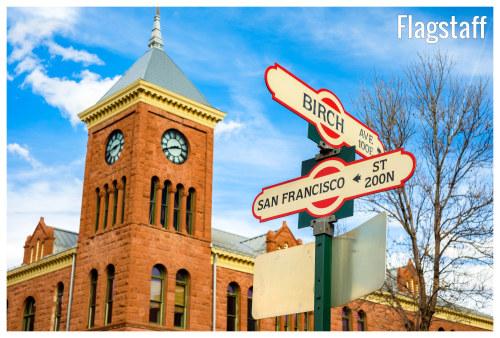
Climate and monthly weather forecast
The climate of Flagstaff
Temperature variations are considerable between the coldest month, January, and the warmest month, July. In January, the average high temperature hovers near 42.6°F (5.9°C) with nighttime averages descending to 25.2°F (-3.8°C). In direct contrast, July experiences an average high of 82.8°F (28.2°C) and a nighttime average of 60.4°F (15.8°C).
Humidity ranges between 24% in June, making it the driest month, to 66% in January, making it the most humid month of the year. The city enjoys a fair amount of sunshine averaging from 6.8 hours a day in December to 12.2 hours a day in June. The city sees most of its rain in July, averaging 2.56" (65mm) spread across 16.2 days, while the least rainfall occurs in June with an average of just 0.24" (6mm) over three days.
Flagstaff also exhibits unique weather patterns. Noticeably, a sharp dip in sunshine days is seen during July and August, dropping to 11.4 and 12.3 days respectively, despite longer daylight hours.
The Best Time to Visit Flagstaff
The Worst Time to Visit Flagstaff
Spring Weather in Flagstaff
Summer Weather in Flagstaff
Autumn Weather in Flagstaff
Winter Weather in Flagstaff
Weather in January
Weather in February
Weather in March
Weather in April
Weather in May
Weather in June
Weather in July
Weather in August
Weather in September
Weather in October
Weather in November
Weather in December
Published by: Weather U.S. | About Us
Data Sources | Weather Forecasting & Climate
Frequently asked questions
What part of the year is the coldest in Flagstaff?
What is the most humid month in Flagstaff?
How many days does it rain in Flagstaff?
When does it snow in Flagstaff?
How many days does it snow in Flagstaff?
What are the months with the lowest UV index in Flagstaff?
What is the least humid month in Flagstaff?
What is the driest month in Flagstaff?
When it does not snow in Flagstaff?
When are the longest days in Flagstaff?
What is the month with the most sunshine in Flagstaff?
What is the month with the highest UV index in Flagstaff?
What month is the hottest in Flagstaff?
What is the wettest month in Flagstaff?
When does it snow the most in Flagstaff?
What is the month with the shortest days in Flagstaff?
Is there Daylight Saving Time (DST) in Flagstaff?
What is the month with the least sunshine in Flagstaff?

Average temperature
Flagstaff, AZ
The warmest month (with the highest average high temperature) is July (82.8°F).
The months with the lowest average high temperature are January and December (42.6°F).
The month with the highest average low temperature is July (60.4°F).
The coldest month (with the lowest average low temperature) is December (24.8°F).
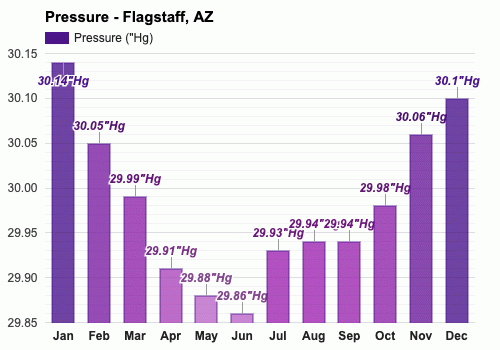
Average pressure
Flagstaff, AZ
- Average pressure in January:
30.14"Hg - Average pressure in February:
30.05"Hg - Average pressure in March:
29.99"Hg - Average pressure in April:
29.91"Hg - Average pressure in May:
29.88"Hg - Average pressure in June:
29.86"Hg
- Average pressure in July:
29.93"Hg - Average pressure in August:
29.94"Hg - Average pressure in September:
29.94"Hg - Average pressure in October:
29.98"Hg - Average pressure in November:
30.06"Hg - Average pressure in December:
30.1"Hg
The month with the highest atmospheric pressure is January (30.14"Hg).
The month with the lowest atmospheric pressure is June (29.86"Hg).

Average wind speed
Flagstaff, AZ
- Average wind speed in January:
6.5mph - Average wind speed in February:
7.6mph - Average wind speed in March:
8.4mph - Average wind speed in April:
9.6mph - Average wind speed in May:
9.4mph - Average wind speed in June:
9mph
- Average wind speed in July:
6.3mph - Average wind speed in August:
5.8mph - Average wind speed in September:
6.5mph - Average wind speed in October:
7.1mph - Average wind speed in November:
7.3mph - Average wind speed in December:
6.9mph
The windiest month (with the highest average wind speed) is April (9.6mph).
The calmest month (with the lowest average wind speed) is August (5.8mph).

Average humidity
Flagstaff, AZ
The month with the highest relative humidity is January (66%).
The month with the lowest relative humidity is June (24%).

Average rainfall
Flagstaff, AZ
- Average rainfall in January:
0.79" - Average rainfall in February:
1.1" - Average rainfall in March:
0.91" - Average rainfall in April:
0.55" - Average rainfall in May:
0.75" - Average rainfall in June:
0.24"
- Average rainfall in July:
2.56" - Average rainfall in August:
1.93" - Average rainfall in September:
0.98" - Average rainfall in October:
0.71" - Average rainfall in November:
0.94" - Average rainfall in December:
1.1"
The wettest month (with the highest rainfall) is July (2.56").
The driest month (with the least rainfall) is June (0.24").

Average rainfall days
Flagstaff, AZ
- Average rainfall days in January:
3.4 days - Average rainfall days in February:
2.5 days - Average rainfall days in March:
5.3 days - Average rainfall days in April:
5.6 days - Average rainfall days in May:
4.8 days - Average rainfall days in June:
3 days
- Average rainfall days in July:
16.2 days - Average rainfall days in August:
14 days - Average rainfall days in September:
9 days - Average rainfall days in October:
4.9 days - Average rainfall days in November:
2.5 days - Average rainfall days in December:
3.6 days
The month with the highest number of rainy days is July (16.2 days).
The months with the least rainy days are February and November (2.5 days).

Average snowfall
Flagstaff, AZ
- Average snowfall in January:
4.65" - Average snowfall in February:
5.94" - Average snowfall in March:
4.09" - Average snowfall in April:
2.2" - Average snowfall in May:
0.47" - Average snowfall in June:
0"
The month with the highest snowfall is December (7.36").
The months with the least snowfall are June, July, August and September (0").
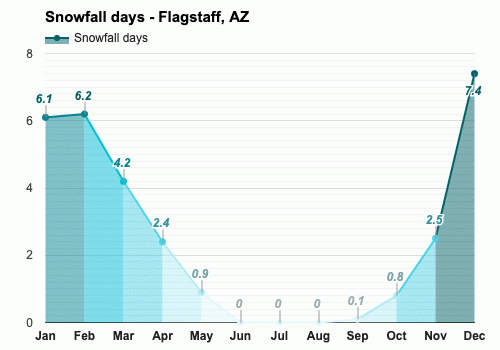
Average snowfall days
Flagstaff, AZ
- Average snowfall days in January:
6.1 days - Average snowfall days in February:
6.2 days - Average snowfall days in March:
4.2 days - Average snowfall days in April:
2.4 days - Average snowfall days in May:
0.9 days - Average snowfall days in June:
0 days
- Average snowfall days in July:
0 days - Average snowfall days in August:
0 days - Average snowfall days in September:
0.1 days - Average snowfall days in October:
0.8 days - Average snowfall days in November:
2.5 days - Average snowfall days in December:
7.4 days
The month with the highest number of snowfall days is December (7.4 days).
The months with the least snowfall days are June, July and August (0 days).
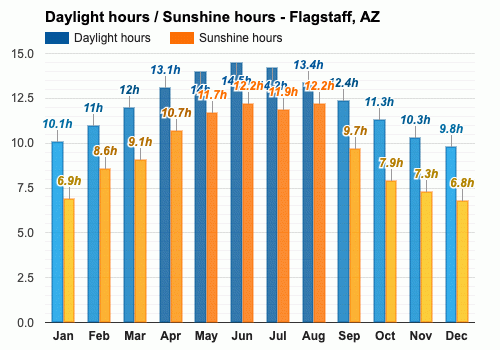
Average daylight / Average sunshine
Flagstaff, AZ
- Average daylight in January:
10h and 1min - Average daylight in February:
10h and 5min - Average daylight in March:
12h and 0min - Average daylight in April:
13h and 1min - Average daylight in May:
14h and 0min - Average daylight in June:
14h and 3min
- Average daylight in July:
14h and 2min - Average daylight in August:
13h and 2min - Average daylight in September:
12h and 2min - Average daylight in October:
11h and 2min - Average daylight in November:
10h and 2min - Average daylight in December:
9h and 5min
The month with the longest days is June (Average daylight: 14h and 30min).
The month with the shortest days is December (Average daylight: 9h and 48min).
- Average sunshine in January:
6h and 5min - Average sunshine in February:
8h and 4min - Average sunshine in March:
9h and 1min - Average sunshine in April:
10h and 4min - Average sunshine in May:
11h and 4min - Average sunshine in June:
12h and 1min
- Average sunshine in July:
11h and 5min - Average sunshine in August:
12h and 1min - Average sunshine in September:
9h and 4min - Average sunshine in October:
7h and 5min - Average sunshine in November:
7h and 2min - Average sunshine in December:
6h and 5min
The months with the most sunshine are June and August (Average sunshine: 12h and 12min).
The month with the least sunshine is December (Average sunshine: 6h and 48min).

Average sunshine days
Flagstaff, AZ
- Average sunshine days in January:
23.4 days - Average sunshine days in February:
20.8 days - Average sunshine days in March:
22.9 days - Average sunshine days in April:
22.9 days - Average sunshine days in May:
23.5 days - Average sunshine days in June:
25.8 days
- Average sunshine days in July:
11.4 days - Average sunshine days in August:
12.3 days - Average sunshine days in September:
17.8 days - Average sunshine days in October:
24.2 days - Average sunshine days in November:
25.3 days - Average sunshine days in December:
22.4 days
The month with the most sunshine days is June (25.8 days).
The month with the least sunshine days is July (11.4 days).

Average UV index
Flagstaff, AZ
The months with the highest UV index are June, July and August (UV index 6).
The months with the lowest UV index are January, February, November and December (UV index 2).

Average cloud cover
Flagstaff, AZ
The month with the most cloud cover is December (Cloud cover 24).
The month with the least cloud cover is June (Cloud cover 7).
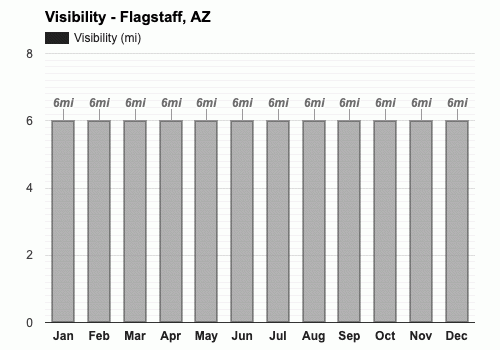
Average visibility
Flagstaff, AZ
The months with the highest visibility are January, February, March, April, May, June, July, August, September, October, November and December (6mi).
The months with the lowest visibility are January, February, March, April, May, June, July, August, September, October, November and December (6mi).